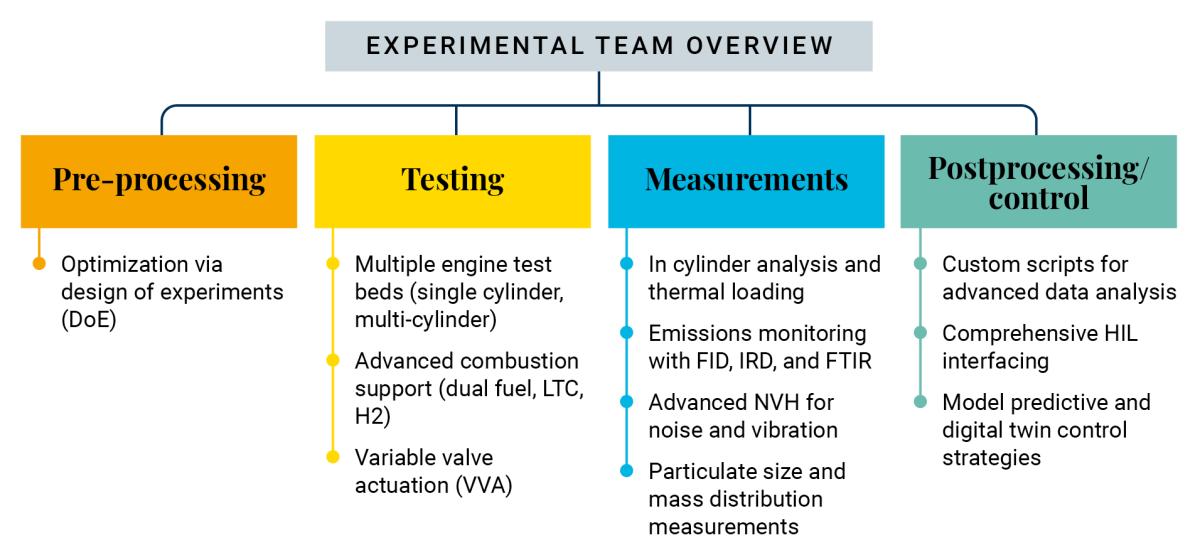Experimental research
Our Experimental research subgroup is dedicated to addressing the intricate challenges of experimental research in large-bore internal combustion engine development. We have established a suite of flexible experimental test benches, essential for our ambitious projects, equipped with cutting-edge measurement technology and integrated into a streamlined system for data acquisition and post-processing. Grounded in deep expertise in mathematics, physics, and signal analysis, our approach enables detailed insights into powertrain systems. This analytical rigour, combined with sophisticated design of experiments and model-in-the-loop simulations, allows us to refine our simulation models to the highest degree of accuracy. Additionally, our capabilities extend to full hardware-in-the-loop integration, crucial for testing and validating advanced powertrain control solutions, ensuring our team plays a pivotal role in advancing innovative powertrain technologies.
Pre-processing, testing, measurement and post-processing
Pre-processing
In the pre-processing phase, we focus on optimising our experiments through meticulous design of experiments (DoE). This step is crucial as it sets the foundation for all subsequent testing and analysis. By employing advanced DoE techniques, we ensure that our experimental setups are both efficient and effective, allowing us to explore a wide range of engine parameters systematically.
Testing
Our testing capabilities are both comprehensive and cutting-edge. We operate multiple engine test beds, including single-cylinder and multi-cylinder setups, supporting advanced combustion techniques such as dual-fuel, LTC, and hydrogen combustion. Additionally, we are equipped with Variable Valve Actuation (VVA) capabilities and employ Model Predictive and Digital Twin Control strategies to enhance our testing processes. Our rapid prototyping and model-based control approaches ensure that we can quickly adapt and respond to new challenges, maintaining our position at the forefront of engine testing technology. These comprehensive setups enable us to conduct fundamental combustion research, as well as detailed sensitivity and optimisation studies, ensuring that we can tackle a wide range of experimental scenarios.
Measurement
Precision and accuracy are at the core of our measurement techniques. We conduct in-cylinder analysis and monitor thermal loading, emissions, and particulate size and mass distribution. Our lab is equipped with advanced NVH tools to assess noise and vibration, ensuring a comprehensive understanding of engine performance. By integrating FID, IRD, and FTIR technologies, we showcase our expertise in accurately measuring and quantifying engine emissions. These precise measurements are critical for validating our models and ensuring the reliability of our data. You can visit the lab website for more details regarding the lab equipment.
Post-processing
Our post-processing capabilities are designed to transform raw data into actionable insights. Utilising custom scripts for advanced data analysis, we offer comprehensive Hardware-in-the-Loop (HIL) interfacing to support system testing and validation. This allows us to seamlessly integrate experimental data with simulation models, enhancing our understanding of complex engine behaviours. Our tailored post-processing routines ensure each project benefits from a unique, reliable, and innovative approach.
Our lab’s holistic approach, from meticulous pre-processing to advanced post-processing, ensures that we not only meet but exceed the demands of modern engine research and development. Join us as we pioneer new frontiers in powertrain technology, driving forward the capabilities of tomorrow’s engines today.


